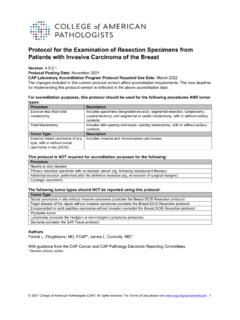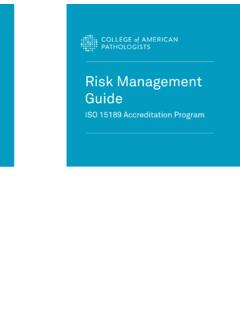Transcription of Table of Contents
1 Table of Contents 2022 Hematology, Clinical Microscopy, and Body Fluids Glossary Blood Cell Identification .. 1 Granulocytes and 1 9 Erythrocyte Inclusions ..15 Lymphocytes and Plasma C ells ..17 Mega ka ryocytes and Platelets ..22 Microorganisms ..25 Miscellane ous ..28 Artifacts ..30 References ..31 Bone Marrow Cell Identification Introduction ..33 Granulocytes and Monocytes ..33 Erythrocytes ..41 Lymphocytes and Plasma C ells ..45 Mega ka ryocytes ..50 Microorganisms ..52 Miscellane ous ..54 Artifacts ..60 References ..61 Urine Sediment Cell Identification Introduction ..63 Urinary Cells ..63 Leukocytes (Eosinophil, Lymphocyte, Neutrophil, and Monocyte) ..64 Other Mononuclear C ells, Unstained ..66 Urinary Casts ..69 Urinary Crystals ..72 Organisms ..74 Miscellane ous/Exog enous ..75 References ..77 Cerebrospinal Fluid (CSF) and Body Fluid Cell Identification Introduction.
2 78 Erythrocytes ..78 Lymphocytes and Plasma C ells ..79 Granulocytes ..81 Mononuclear Phagocytic C ells ..82 Lining Cells ..84 i 800-323-4 040 | 847-832-7000 Option 1 | Miscellane ous Cells .. 86 Crystals .. 89 Microorganisms .. 91 Miscellane ous Findings .. 93 References .. 93 Clinical Microscopy Miscellaneous Cell Identification Introduction to Vaginal Wet Preparation .. 95 Vaginal Cells .. 95 Organisms .. 97 References .. 97 Introduction to Nasal Smears and Stained Stool for E osinophils .. 97 References .. 98 KOH P repa rations for F ung i .. 100 References .. 100 Pinwor m Preparations .. 101 References .. 101 ii 800-323-4 040 | 847-832-7000 Option 1 | 2022 Hematology, Clinical Microscopy, and Body Fl uids Glossary The College of American Pathologists The College of American Pathologists Hematology and Clinical Microscopy Committee Eric D. Hsi, MD, FCAP, Chair Olga Pozdnyakova, MD, PhD, FCAP, Vice Chair Archana M.
3 Agarwal, MD, FCAP Aadil Ahmed, MD, FCAP Catalina Amador, MD, FCAP Salman Ayub, MD, FCAP Holly E. Berg, DO, Junior Member Jonathan Galeotti, MD, MS, FCAP David Douglas Grier, MD, FCAP Alexandra E. Kovach, MD, FCAP Chad M. McCall, MD, FCAP Shar Nozad, MD, FCAP Sarah Lynn Ondrejka, DO, FCAP Anamarija Perry, MD, FCAP Philipp Raess, MD, PhD, FCAP Julie A. Rosser, DO, FCAP Teresa Scordino, MD, FCAP Timothy Skelton, MD, PhD, FCAP Mina L. Xu, MD, FCAP Linsheng Zhang, MD, PhD, FCAP Stephanie A. Salansky, MEd, MS, MT(ASCP), Staff iii 2022 Hematology, Clinical Microscopy, and Body Fl uids Glossary The College of American Pathologists 800-3 23-4 040 | 847-832-7000 Option 1 | 1 800-323-4 040 | 847-832-7000 Option 1 | 1 Blood Cel l Identification Introduction This glossary cor responds to the master list for hematology, a nd it will assist surve y partic ipants in the proper identification of blood cells in photographs and vi rtual slides.
4 Descriptions are f or cells found in blood smears stained with Wright-Giemsa unless otherwise indicated. Granulocytes and Monocytes Basophil , Any Stage Basophils have a maturation sequenc e a na logous to neutrophils. At the myelocyte st age , whe n specific g ranules begin to develop, basophil precursors can be identified. All ba sophils, from the basophilic myelocyte to the mature s egment ed basophil, are characterized by the presence of numerous coarse a nd densely stained granules of varying sizes and shape s. The g ranules are l arger t han the granules of neutrophils and most are roughl y spherical. The g ranules are t ypi cally blue-black, but some may be purple-red whe n stained using Wright-Giemsa preparations. The granules are uneve nly distributed and frequently overlay and obscur e the nucleus. Basophils are c omparabl e in size to ne utrophils, ie, 10 to 15 m in diameter, a nd the nuclear-to-cytoplasm (N:C) ratio* ranges from 1:2 to 1:3.
5 Basophilia may be s een in several contexts, including in association with myeloproliferative neoplasms, in hype rsensitivity reactions, with hypothyroidism, iron de ficienc y, a nd rena l disease. Basophil granules can be st ained with toluidine blue (resulting in a purple c olor) to differentiate them from the g ranules of neutrophils. * For the purpose of this g lossary, N:C ratio is defined as the ratio of nuclear volume to cytoplasmic ( non-nuclear) cell volume. Eosinophil, Any Stage Eosinophils are r ound-to-oval leukocytes that a re r ecognizable b y their c haracteristic coarse, orange-red granulation. The y are c omparable in size to neutrophils, ie, 10 to 15 m in diameter in their mature f orms, and 10 to 18 m in diameter in immature f or ms. The e osinophil N:C ratio ranges f rom 1:3 for matur e f or ms to 2:1 for immatur e f or ms. The e osinophil cytoplasm is gene rally eve nl y filled with numerous coa rse, orange-red granules of uniform size.
6 The se g ranules r arely overlie the nucleus and are refractile b y light microscopy due to the ir c rystalline struc ture. T his refractile a ppearance is not Blood Cell Identification 2 800-323-4 040 | 847-832-7000 Option 1 | apparent in photomicrographs or pictures, howeve r. Due to inherent problems with color rendition on photomicrographs, which is sometimes imperfect, eosinophil granules may appear l ighter or darke r t ha n on a f reshly stained blood film. Discoloration may give t he granules a blue, brown, or pink tint. Nonetheless, the unifor m, coa rse nature of e osinophil granules is cha racteristic a nd differs from the smaller, f iner granules of n eut rophils. Occasionally, e osinophils can become degranulated, with only a few o range-red granules remaining visible w ithin the faint pink cytoplasm.
7 In the most mature e osinophil for m, the nucleus segments into two or more lobes connected by a thin fila ment. About 80% of s egmented eosinophils will have the c lassic two- lobed appearance. Typically, these lobes are of e qual size a nd round to ovoid or potato shaped with dense, c ompact chr omatin. The remainder of s egmented eosinophils will have three lobes and an occasional cell will exhibit f our to five lobes. Eosinophils exh ibit the same nuclear c haracteristics and the s ame st age s of development as neutrophils. Immature eosinophils are r arely seen in the blood, but they are identifiable in bone marrow smears. Immature e osinophils may ha ve f ewer granules than more mature f or ms. The e arlie st recognizable e osinophil by light micros copy is the eosinophilic myelocyte. Eosinophilic myelocytes often contain a few d ark purplish granules ( pr imary granules) in addition to the orang e-red secondary granules.
8 Mas t Cel l The mast cell is a l arge ( ie, 15 to 30 m in diameter) r ound or e lliptical cell with a small, round nucleus and abundant cytoplasm fill ed with black, bluish black, or reddish-purple metachromatic g ranules. N or mal mast cells are differentiated from blood basophils by the fact that they are l arger (of ten twice the si ze of blood basophils), have more a bundant cytoplasm, and have r ound rather than segmented nuclei. The c ytoplasmic granules are smaller, more numerous, more unifor m in appearance, and less water-extractable than ba sophil cytoplasmic g ranules. Although both mast cells and basophils are primarily involved in allergic a nd ana phylactic r eactions via release of bioactive subs tances through degranulation, the c ontents of their granules are not identical. Mast cell granules can be stained with toluidine blue (resulting in a purple c olor) to differentiate them from the granules of n eutrophils.
9 Monocyte Monocytes are slightly large r than neutrophils, rang ing from 12 to 20 m in diameter. The majority of monocytes are r ound with smooth edges, but some may ha ve pseudopod-like c ytoplasmic e xtensions. The c ytoplasm is abundant, with a g ray or gray-blue g round-glass appearance, and may contain vacuoles or f ine, e venl y distributed azur ophilic g ranules. The N :C ratio ranges f rom 4:1 to 2:1. The nucleus is usually indented, often resembling a three-pointed hat, but it can also be f olded or band-like. Blood Cell Identification 3 800-323-4 040 | 847-832-7000 Option 1 | The c hr omatin is condens ed but is usually less dense than that of a n eutrophil or lymphocyte. Nucleoli are g enerally abs ent, but occasional monocytes may contain a small, inconspicuous nucleolus. Monocyte, Immature (P romonocyte, Monoblast) For the purposes of proficienc y testi ng, selection of the response monocyte, immature (pr omonocyte, monoblast) should be reserve d for maligna nt cells in the c ontext of acute monocytic /monoblastic leukemia, a cute myelomonocytic l eukemia, c hronic myelomonocytic l eukemia, or myelodysplastic s yndromes.
10 While immature monocytes may be normally identified in marrow a spirates, they are generally inconspicuous a nd do not resemble the cells described in this section. The maligna nt monoblast is a l arge c ell, usually 15 to 25 m in diameter. It has relatively more c ytoplasm than a myeloblast with the N :C ratio rang ing from 7:1 to 3:1. The monoblast nucleus is round or oval a nd has finely dispersed chr omatin and distinct nucleoli. The c ytoplasm is blue to gray-blue a nd may contain small, scattered azur ophilic granules. Some monoblasts cannot be distinguished morphologically from other blast for ms; in these instances, additional tests (eg, cytoc he mistry and/or f low c ytometry) are required to accurately assign blast lineage. Promonocytes have nuclear a nd cytoplasmic c haracteristics that a re between those of monoblasts and mature monocytes. They are g enerally large r than mature monocytes, but they have similar-appearing gray-blue c ytoplasm that often contains unifor mly distributed, fine a zur ophilic g ranules.









